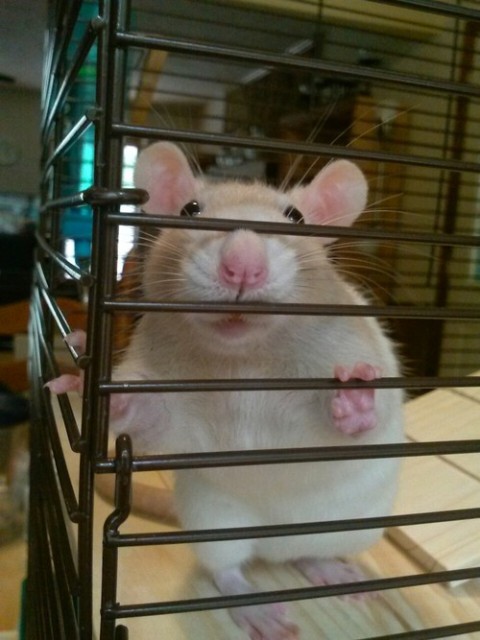Rats on Rats
June, my eldest rat, probably thinks that she’s about to get a treat. She probably is.
Rodents in general, but specifically rats, have a reputation for being vile, dirty little creatures. “Well, rats brought the plague!” One argument. “ Rats are nasty; nothing you could find in the sewers could be cleanly!” Another argument. A lot of people also think Obama is a lizard. Most of these arguments are assumptions, though, even just a case of misinformation. People generally seem to be ignorant to the glorious nature of the rodent, and that’s why I am here presently, writing this article to dispel any miss-thought about the domesticated rat (though I don’t quite know how to address those who believe Obama to be a reptile—maybe an idea for another article?)
Rodents, firstly, are immaculately clean animals, rats especially. They tend to clean themselves at least six times daily, which is more often than a house-cat. With addressing cleanliness promptly, it’s next necessary to explain the myth that all rats carry diseases. The rats sold and bread in stores today are not the same animals as the filthy sewer rats that carried the bubonic plague which successfully eradicated over half of the European population in a matter of years. Using the cat as an example again, a mountain lion and an american short hair are both technically felines but we recognize the difference. You’re more likely to contract some type of infection from a stray dog or a squirrel than a rat, yet we associate the cliched shrieking housewife with the latter.
The modern day domesticated rat comes in several flavors, but there are two types atypically sold at most pet stores—fancy and dumbo rats. The differences between each is size; as expected, dumbo rats are normally larger than fancy rats and have the distinguishing feature of larger, floppier ears that lay the the side of their heads rather than atop. Dumbo rats are coined “gentle giants,” though, much like most animals, I’ve never met a properly-cared-for rat that has been anything but pleasant. Like most domesticated animals, rats harbor an abundances of difference coats among the animals; hairless rats are even an option for those with allergies. Aside from breeding purposes, which you shouldn’t being doing unless you’re completely capable, male and female rates should be kept separate. While each sex in enjoyable singularly, when they’re kept together male rats have a nasty tendency to harass the lady rat, blocking them from their food as well as other physical aggressions.
Withholding the gender segregation rule, rats should always be bought in pairs, at least. All rodents are social creatures and without companionship they tend to become stressed. Stress enacting on such a small anatomy can be devastating, leading to illness and in the worst case death. Overwhelming stress is usually expressed through a lack of appetite, a moreso skittish nature, excessive sleep, and a redish excretion called porphyrin through the tear ducts and nostrils. Porphyrin does not always indicate stress; it is normal is small amounts but should still be monitored. Rats have very weak respiratory systems and the presence of the substance sometimes indicates a more serious problems in their lungs. A good, easy way to keep your rats from becoming too stressed is getting them out frequently and letting them run around and explore. Spending this time with them will not only help their health, but will make them more comfortable and relaxed with you as well.
While many small pets are, well, boring, rats are highly adventurous and just as affectionate. Rats are flexible and smart, actually owning a reflex which disallows them from falling or jumping from a distance longer than their own body or outside of their own reach. Rats can even talk, or “chitter.” In rubbing their teeth together rapidly they create a sort of clicking sound that can either express happiness, show location, or sometimes is just a reflex—rat’s teeth never cease growing throughout their entire life. Much like dogs, rats can be taught to fetch, follow, pull, and even more. Due to their teeth they also enjoy chew toys. Unlike dogs, rats can eat chocolate.
Depending on the breed, rats can live anywhere from two to five years, but tend to go earlier due to their weak constitutions and respiratory systems. They are happy, laid-back animals that are not expensive in the least to maintain. Though inexpensive, like any animal they are a responsibility to be taken seriously. The work is menial in comparison to the return, though—the return being a loving pet to come home to every day. Unlike my mother who never wanted me.

Joley Odom is a temperamental teen robot with the insatiable thirst to learn. Or maybe not. Sometimes she seems sort of mean, but she really isn’t. Don’t...











